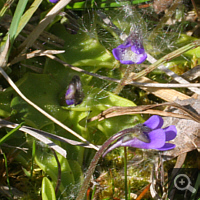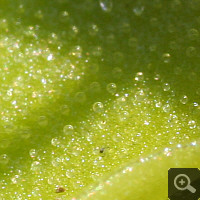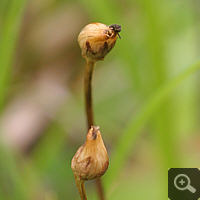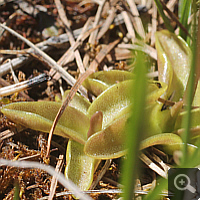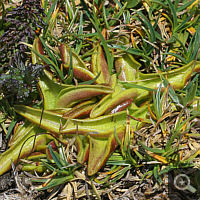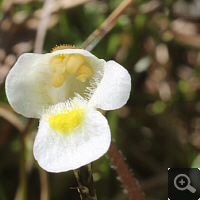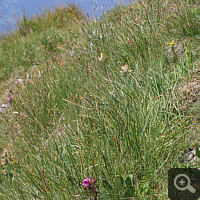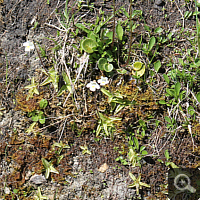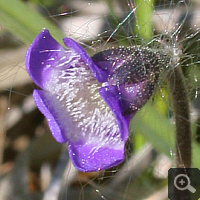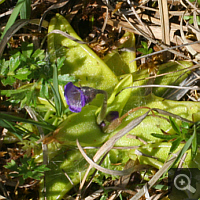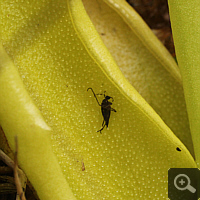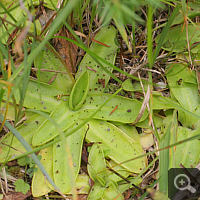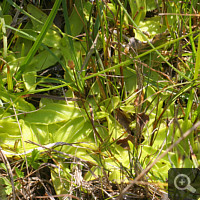Butterworts (Pinguicula) in their natural German habitat
Introduction
The genus from the bladderwort family is widespread with circa 90 species in the whole northern hemisphere. Butterworts are (apart from a few species) perennial, rosette-building species. The leaves are between a few to almost 30 centimetres long and mostly rotund, less frequent elongated to filiform. Mostly pink to purple violet-like flowers are produced. Other flower colours are rare. Main distribution area is Mexico, most species there are heterophyll plants, produce succulent hibernal leaves therefore. In the tropical and subtropical regions exist in addition some homophyll butterworts with only one leaf shape throughout the year. Furthermore exist a whole series of species from the temperate zones, which are partly very frost-hardy. Also here exist homophyll and heterophyll plants. However, in Germany are to be found only two species, namely Pinguicula alpina and Pinguicula vulgaris.
On the one hand are short-stalked tentacles located on the leaf surface, in addition non-stalked glands. The capture mucus, which is based on a polysaccharide solution, is secreted by the tentacles. Butterworts produce a number of enzymes, wherewith the prey, which consist first and foremost of small flies, are digested. The cleavage products are reabsorbed by sessile glands.
Butterworts class among the active flypaper traps. Admittedly the tentacles are immobile, but it exists a more or less distinct ability to a movement of the leaf. Sometimes this ability is only marginal marked and at best a slight dent of the leaf is to be found in the area of the prey, so that this swims in a mere of enzyme-rich digestion liquid. But in addition exist also species, which show especially at the leaf margin region a more distinct leaf mobility.
Alpine butterwort (Pinguicula alpina)
This very interesting species was described already 1753 by Carl von Linné. Nowadays it is classed together with some Asian species in the section Micranthus of the subgenus Temnoceras. Pinguicula alpina is protected according to the Federal Species Conservation Act.
The distribution area comprises in Europe Scandinavia, the Alps, the Pyrenees as well as the Carpathian Mountains, but trends eastwards up to the Himalaya Mountains. Mainly are chalky, partly loamy soils with a low vegetation settled. Sometimes you can find this species accompanied by other butterwort species, as Pinguicula vulgaris, Pinguicula leptoceras or Pinguicula grandiflora.
The perennial plant produces in the course of the year two different leaf types. In late autumn non-carnivorous, circa 1 cm long winter leaves are produced, which stand together densely and thus build the winter rosette (hibernaculum).
Then in spring, carnivorous leaves develop from hibernaculum. Seldom they reach a length of more than 3 cm. Leaves show several identification-relevant characteristics. Leaf margins are often turned, in the case of a sunny location are especially the leaf margins reddishly tinged. Most important characteristic for identification is nevertheless the absence of digestive glands and tentacels along the midrib. As already mentioned at the beginning, this species belongs to the active flypaper traps.
In spring appear the circa 1,5 cm in diameter measuring, white flowers. Characteristical is a yellow spot in the middle of the lower corolla lobe.
I have found this species near Oberstdorf in July 2012. The habitat was located circa 2.200 m above sea level at a moist mountain slope. In addition to several orchid species it was in close vicinity accompanied by the Mountain avens.
In Austria found I the species in July 2013 near Bad Mitterndorf on 1.700 m above sea level. Also this biotope was a sprinkled mountain slope.
Common butterwort (Pinguicula vulgaris)
Also this species was already 1753 described by Carl von Linné. Today it is classed in the section Pinguicula of the subgenus Pinguicula. Pinguicula vulgaris is protected according to the Federal Species Conservation Act.
The distribution area of Pinguicula vulgaris is really large. The species is native in the most regions of Europe and the northern parts of America as well as Asia. In Germany it is to be found especially in the South and is yet again within the Allgäu and Alps quite common.
The constantly damp sites are characterised by a low vegetation. Regarding of the pH-value has the species a relative large amplitude – grown are moderate acid habitats as well as neutral or alkaline. Soil can thus consists of peat but also of loam or limestone with a slight topsoil.
The perennial plant produces in the course of the year – just as Pinguicula alpina – two different leaf types. In late autumn non-carnivorous, circa 1 cm long winter leaves are produced, which stand together densely and thus build the winter rosette (hibernaculum).
Then in spring, carnivorous leaves develop from hibernaculum. These reach a length of circa 5 cm, but sometimes also significantly more. Leaves are bright green, very seldom slight reddishly tinged in the case of a good solar radiation. Leaf margins are only slightly turned. In contrast to Pinguicula alpina is also midrib equipped with digestive glands and tentacels.
According to recent researches Pinguicula vulgaris lives on fungus gnats and especially pollen. In spring these should be to circa 70% nitrogen provider.
The violet flowers appear between late April and early June. They have approximately a length of 2 cm, from which the half is apportioned to the spur. In contrast to the most other butterwort species, the petals are not spread out, they lean together, so that the flower has a tubular aspect.
I have already found this species in many habitats in South Germany. Mainly these are fens. But in addition I found the species also at moist waysides or on the waterfront of small ponds. Interesting is the amplitude of the leaf length. In most cases these are shorter than 5 cm, but in the district Bad Tölz I have also seen plants with a leaf length of circa 12 cm.

